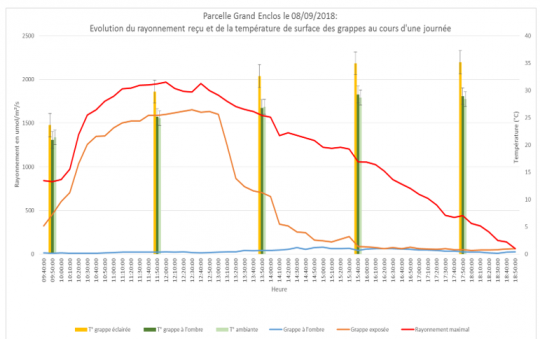Several leaf thinning trials have been conducted internally. In view of climate change, this practice which seemed indispensable a few years ago is now being questioned, or at least whether it should be used systematically.
On plots with low vigour, low susceptibility to diseases and/or being particularly early, leaf thinning is no longer carried out on a systematic basis.
Trials where leaves are not removed have been conducted to understand in more detail the impact on the microclimate, the aromatic profile of the wines and cryptogamic management given the current climate.
The following are the results from a 2018 trial, which built on previous trials.
2.3.8.e Trials to determine the impact of leaf thinning on the bunches' microclimate
Method
The study was based on four of the property's plots.
| | Grand Enclos | Gravette | Bois de Latour | Petit Batailley 7 |
|---|---|---|---|---|
| Rootstock | 101-14 MGt | SO4 (West) et G1 (East). | Riparia Gloire de Montpellier | 101-14 MGt |
| Varietal | Cabernet Sauvignon | Cabernet Sauvignon | Merlot (black) | Merlot (black) |
| Average age of the vines | 12 years | 50 years | 90 years | 14 years |
| Pedology | To the west: graveled Brunisol | To the East : Sedimentary planosols | Sandy-Graveled Arenosols | Sandy reductisols |
| To the East: Planosol on bariolated clays and sandy-gravelly arenosols | To the West : graveled Brunisol | |||
| Vigor | Poor to average | Average | Average to strong | Average to strong |
Three procedures were tested:
| Method | Itinerary | Leaf thinning period |
|---|---|---|
| M1 | Without leaf thinning - Without thinning | / |
| M2 | Without leaf thinning – Thinning after fruit set | Between June 20th-30th |
| M4 | Control - Leaf thinning - Thinning following fruit set | Between June 20th-30th |
Leaf thinning on one side only, sunrise side, around the bunches. Removal of secondary growth only concerns side shoots.
Measurements
- Estimate of the number of exposed and unexposed bunches
- Measurement of sunshine
- Measurement of berry temperature
- Measurement of the incidence of fungal diseases.
- Monitoring of bunch microclimate
- Measurement of spray efficiency
- Measurement of water stress
- Measurement of ABVp, pH, assimilable nitrogen, TA, malic acid
- Measurement of phenolic compounds
Results
Impact of the Microclimate on the bunches
Not surprisingly, the percentage of exposed bunches is much higher with leaf removal (M4). The differences between M1 (no leaf removal, no removal of secondary growth) and M2 (no leaf removal / removal of secondary growth) are minimal.
| Plot | Measurements over the interval 8h-20h during the period from 01/07 to 15/09 | Average Maximum Temperature (°C) | Average Minimum Temperature (°C) | Average Maximum Humidity (%RH) | Humidity Minimum Average (%RH) |
|---|---|---|---|---|---|
| Bois de Latour | Clusters with thinned leaves | 29,38 | 28,04 | 50,73 | 45,41 |
| Clusters with leaves intact | 26,97 | 25,99 | 58,14 | 53,55 | |
| Difference thinned leaves - unthinned leaves | 2,41 | 2,05 | -7,42 | -8,14 | |
| Grand Enclos | Clusters with thinned leaves | 28,86 | 27,71 | 53,36 | 48,45 |
| Clusters with leaves intact | 28,65 | 27,41 | 53,73 | 48,64 | |
| Difference thinned leaves - unthinnned leaves | 0,22 | 0,3 | -0,36 | -0,19 |
On Grand Enclos (Cabernet-Sauvignon), the differences in temperature and humidity are not significant.
Conversely, on Bois de Latour (Merlot), the differences are significant. This can be explained by greater vigour and larger leaves due to the grape variety. Higher humidity leads to a more favourable microclimate for downy mildew.
However, regarding the threat of cryptogamic diseases, downy mildew frequency and intensity are slightly reduced with leaf removal but we did not observe significant differences. The extreme downy mildew pressure in 2018 probably smoothed the results.
Since overall vigour was moderate, leaf removal had relatively little impact on the efficiency of spaying.
Changes in sunshine and surface temperature of bunches
Exposed berries had a 21% higher temperature than unexposed berries. These measurements show that when the ambient temperature reaches 35°C, the exposed berries can reach temperatures of up to 45°C.
The risk of scalding is thus increased. Moreover, when exposure decreases (nearly no sunshine after 6pm), the temperature of the berries that were exposed is still much higher than that of the berries that were in the shade.
This difference also creates a different wine organoleptic profile in the final wines.
The MND and nonalactone dosage give a partial view of the aromatic impact. These molecules are responsible for odours such as prunes and dried figs, an indicator of premature oxidation.
The plot with leaf removal (M4) had values twice as high the plot with no removal of leaves or secondary growth (the values remain below the perception threshold).
The differences for the other oenological parameters were not significant.
| Plot | Method | MND (ng/L) | g-nonalactone (μg/L) |
|---|---|---|---|
| Grand Enclos Zone A | M2 | 22 | Traces |
| M4 | 45 | 3,1 | |
| Bois de Latour TP | M2 | 29 | Traces |
| M4 | 49 | 2,5 | |
| Perception threshold | 63 | 60 |
Conclusion
For our vines, leaf removal on plots with low disease susceptibility and low vigour seems to be unnecessary.
On more vigorous plots, leaf removal remains an excellent practice to improve the bunches' microclimate.
Leaf thinning is no longer systematic and is now adjusted according to the vigour of the plot, its stage in the growth cycle and its sensitivity to fungal diseases.


